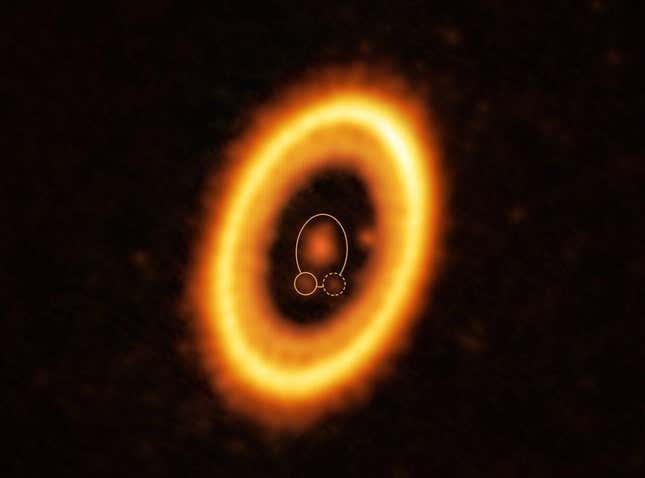A group of radio telescopes in the Chilean desert was aimed at a young star system 400 light years away when it detected something unusual: a cloud of debris chasing a planet along the same orbit. The debris could be a planet in the midst of being born or the remains of one that already exists, making this the first observable case of orbital planetary twins.
The PDS 70 star system hosts two giant Jupiter-like planets known as PDS 70b and PDS 70c. By analyzing archival data collected by the Atacama Large Millimeter/submillimeter Array (ALMA), which is located in the Atacama desert in northern Chile, an international team of astronomers spotted a cloud of debris that’s sharing the same orbit as PDS 70b.
Advertisement
In a new paper published in the journal Astronomy & Astrophysics, the team argues that this could be the strongest observational evidence of Trojan planets. Trojans are rocky bodies that share the same orbit as a planet. The solar system’s own Jupiter has thousands of rocky bodies that lead and follow behind the planet as it orbits the Sun. Trojan exoplanets, on the other hand, are only theorized to exist around stars other than our Sun.
Related article: 7 Things to Know About NASA’s First Mission to the Jupiter Trojan Asteroids
“Exotrojans [Trojan planets outside the Solar System] have so far been like unicorns,” Jorge Lillo-Box, a senior researcher at the Centre for Astrobiology and co-author of the new paper, said in a statement. “They are allowed to exist by theory but no one has ever detected them.”
Advertisement
Advertisement
Trojans exist within two extended regions in a planet’s orbit called the Lagrangian zones, where the combined gravitational pull of the star and the planet can trap material. After observing those two regions of PDS 70b’s orbit, the team of astronomers behind the new study detected a faint signal from one of them. That signal indicated that a cloud of debris with a mass roughly two times that of our Moon is wedged in that gravitational sweet spot.

The above image was taken by ALMA and shows the star system, with the planet PDS 70b highlighted with a solid yellow circle and its tag-along cloud of debris highlighted by a yellow dotted line. The cloud of debris could either be the building blocks of a new planet in the process of formation or an existing Trojan world.
“Who could imagine two worlds that share the duration of the year and the habitability conditions? Our work is the first evidence that this kind of world could exist,” Olga Balsalobre-Ruza, a student at the Centre for Astrobiology in Madrid, Spain, and lead author of the paper, said in a statement. “We can imagine that a planet can share its orbit with thousands of asteroids as in the case of Jupiter, but it is mind blowing to me that planets could share the same orbit.”
Advertisement
Additionally, the ring-like structure in the image is a circumstellar disc of material, from which planets form. The other planet in this system, PDS 70c, is pictured towards the upper right side of the image next to the inner rim of the disc.
The team behind the study are waiting for an observational slot with ALMA in 2026, allowing for follow-up observations of the star system to confirm whether or not PDS 70b and its sibling cloud of debris move in-sync together along their orbit to see how tight those two really are.
Advertisement
More: A Mysterious Object in Deep Space Has Blinked Every 22 Minutes for Over 30 Years
Services Marketplace – Listings, Bookings & Reviews